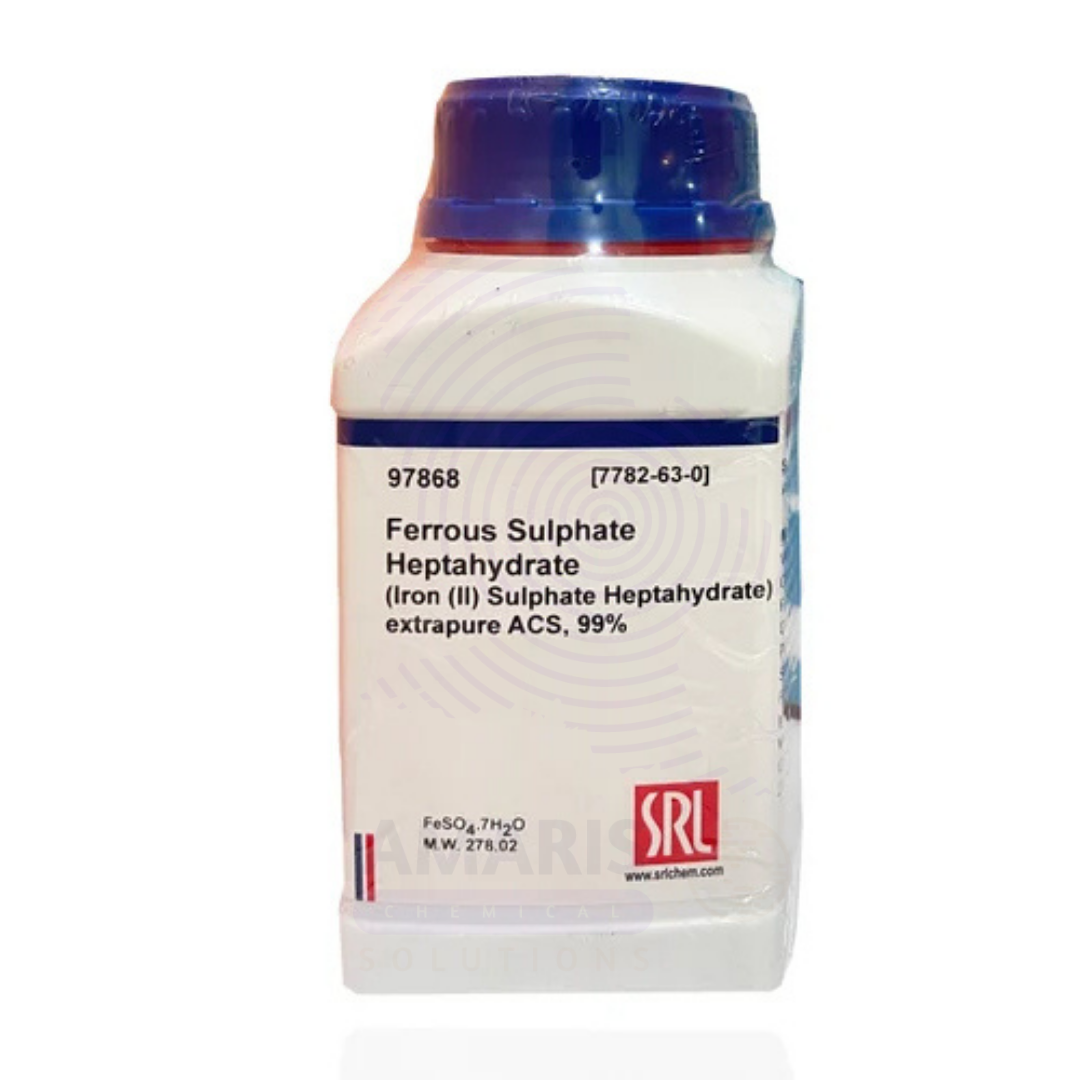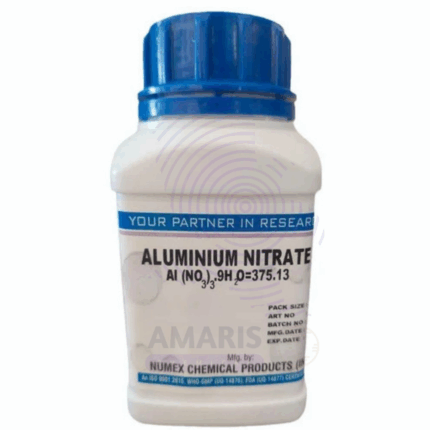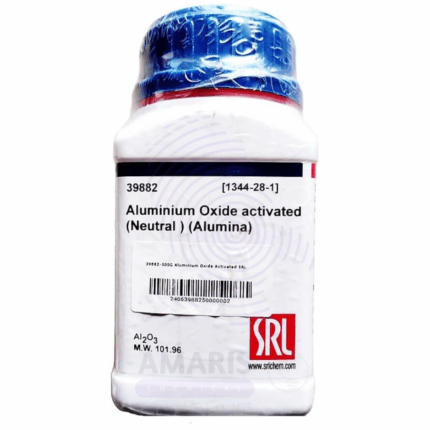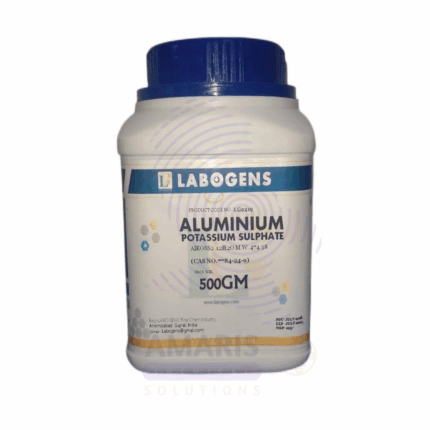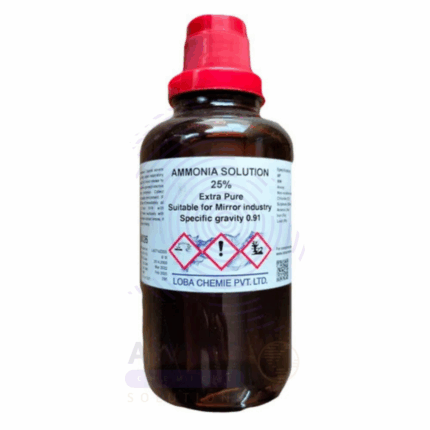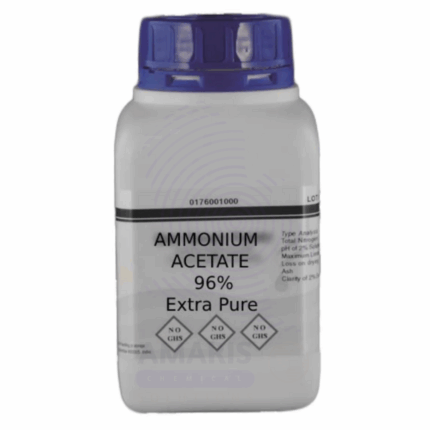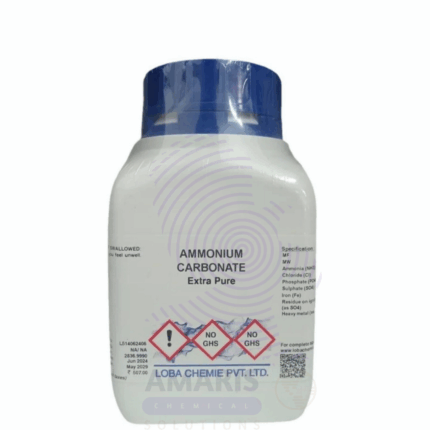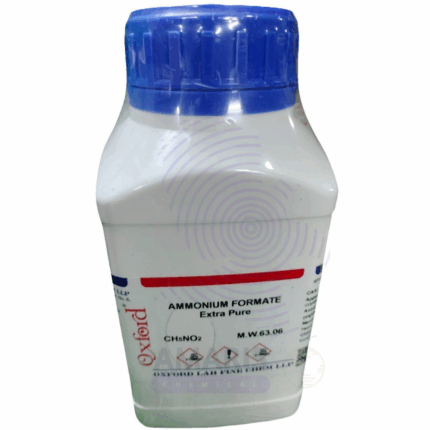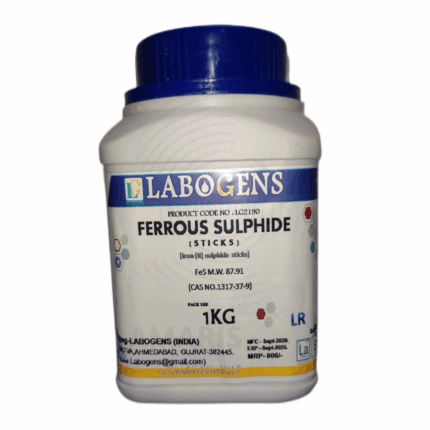
Ferrous Sulphate heptahydrate Extra Pure
$ 17.80 Original price was: $ 17.80.$ 17.67Current price is: $ 17.67.
Ferrous Sulphate heptahydrate Extra Pure is a high-purity laboratory-grade chemical commonly used as a reliable source of ferrous ions (Fe²⁺) in analytical chemistry and educational experiments. With its vivid blue-green crystalline appearance, this compound plays a crucial role in redox reactions, qualitative analysis, and titration procedures. It is frequently utilized in the preparation of iron standards, as a reducing agent, and in experiments that demonstrate oxidation-reduction principles. Due to its high level of purity, it is well-suited for controlled laboratory environments where consistent and accurate results are essential. Proper storage in a cool, dry place is recommended, as the compound is prone to oxidation and moisture sensitivity.
Ferrous Sulphate heptahydrate Extra Pure
Primary Uses
- Source of Fe²⁺ ions:
Commonly used in analytical and inorganic chemistry experiments where ferrous (iron(II)) ions are required. - Reagent in redox titrations:
Acts as a reducing agent in permanganate and dichromate titrations for standardization or analysis of oxidizers. - Precipitation reactions and qualitative analysis:
Helps in identification and separation of anions and cations by forming precipitates with other compounds. - Preparation of iron compounds:
Used to synthesize other iron-based salts and coordination complexes in lab research.
Secondary Uses
- Demonstrations of oxidation states and color changes:
Useful in teaching redox chemistry as Fe²⁺ readily oxidizes to Fe³⁺, showing distinct color changes. - Nutrient in plant physiology experiments:
Serves as an iron supplement in hydroponic and soil studies investigating micronutrient deficiencies. - Simulated wastewater treatment studies:
Applied in lab-scale research to evaluate the role of ferrous ions in phosphate removal or heavy metal precipitation. - Corrosion experiments:
Used to investigate rusting and oxidation of iron, especially in controlled electrochemical studies.
| PACK SIZE |
500 grams Plastic Tin |
|---|
1. Basic Identification Attributes
- Chemical Name: Ferrous Sulphate Heptahydrate
- Synonyms: Iron(II) sulfate heptahydrate, Green vitriol, Copperas
- Chemical Formula: FeSO₄·7H₂O
- Molecular Weight: 278.01 g/mol
- Grade: Extra Pure (Laboratory Reagent Grade, 99%)
- Appearance: Blue-green crystalline solid
- Odor: Odorless
2. Physical & Chemical Properties
- Solubility: Soluble in water
- Melting Point: Decomposes before melting (~64°C loses water)
- pH (5% solution): ~3.0–4.0
- Hygroscopic: Yes
- Stability: Stable under recommended storage; oxidizes slowly in air to form brown iron(III) compounds
3. Safety & Hazard Attributes
- GHS Classification:
- Harmful if swallowed (Acute toxicity Category 4)
- Causes eye irritation (Category 2A)
- May cause respiratory irritation (STOT SE Category 3)
- Hazard Statements:
- H302: Harmful if swallowed
- H319: Causes serious eye irritation
- H335: May cause respiratory irritation
- PPE Requirements:
- Gloves
- Safety goggles
- Lab coat
- Dust mask (if powder is airborne)
- First Aid Measures:
- Inhalation: Move to fresh air; seek medical attention if symptoms persist
- Skin Contact: Rinse with water and soap
- Eye Contact: Flush thoroughly with water for 15 minutes
- Ingestion: Rinse mouth, do not induce vomiting; consult physician immediately
4. Storage & Handling Attributes
- Storage Conditions:
- Store in cool, dry place in tightly sealed container
- Protect from light and air exposure
- Avoid exposure to moisture
- Handling Notes:
- Minimize dust generation
- Avoid breathing dust
- Wash hands thoroughly after use
5. Regulatory & Compliance Attributes
- CAS Number: 7782-63-0
- EC Number: 231-753-5
- UN Number: Not classified as hazardous for transport
- Hazard Class: Not applicable
- Packaging Group: Not applicable
6. Laboratory Applications
- Primary Uses:
- Reagent in redox titrations and analytical chemistry
- Source of ferrous ion in chemical synthesis
- Demonstrating oxidation and crystal growth in experiments
- Secondary Uses:
- Nutrient in plant and algae growth media
- Catalyst in Fenton’s reagent for oxidation studies
- Educational demonstration of iron salt reactions
SAFETY PRECAUTIONS
- Irritant – may cause eye, skin, or respiratory irritation
- Can stain skin and surfaces
- Avoid contact with oxidizing agents and moisture
Storage:
- Store in a cool, dry place, in air-tight containers
- Keep away from light, air, and acids to avoid oxidation
FIRST AID MEASURES
- Inhalation: Move to fresh air; seek attention if irritation persists
- Skin Contact: Wash off thoroughly with soap and water
- Eye Contact: Rinse eyes for several minutes; consult physician if needed
- Ingestion: Rinse mouth; do not induce vomiting; seek medical help
Related products
Aluminium Nitrate Extra Pure
Aluminium Oxide Active Neutral Extra Pure
Aluminium Potassium Sulphate Hydrated Extra Pure
Ammonia Solution Extra Pure
Ammonium Acetate Extra Pure
Ammonium Carbonate Extra Pure
Ammonium Carbonate Extra Pure is a high-quality, white crystalline solid widely used across various scientific, industrial, and food-related applications. Manufactured to stringent purity standards, this compound is ideal for laboratories and processes that demand high-grade reagents. With its characteristic ammonia-like odor and ability to decompose upon heating, ammonium carbonate plays a versatile role in both chemical reactions and physical processes.
In aqueous solution, ammonium carbonate breaks down into ammonium bicarbonate and ammonium carbamate, further releasing ammonia (NH₃) and carbon dioxide (CO₂) upon heating. This property makes it especially useful in applications that require controlled gas release or temporary pH modification.


 Preservatives(food)
Preservatives(food) Flavor Enhancers
Flavor Enhancers Acidulants
Acidulants Sweeteners
Sweeteners Antioxidants
Antioxidants Colorants(food)
Colorants(food) Nutraceutical Ingredients (food)
Nutraceutical Ingredients (food) Nutrient Supplements
Nutrient Supplements Emulsifiers
Emulsifiers
 Collectors
Collectors Dust Suppressants
Dust Suppressants Explosives and Blasting Agents
Explosives and Blasting Agents Flocculants and Coagulants
Flocculants and Coagulants Frothers
Frothers Leaching Agents
Leaching Agents pH Modifiers
pH Modifiers Precious Metal Extraction Agents
Precious Metal Extraction Agents
 Antioxidants(plastic)
Antioxidants(plastic) Colorants (Pigments, Dyes)
Colorants (Pigments, Dyes) Fillers and Reinforcements
Fillers and Reinforcements Flame Retardants
Flame Retardants Monomers
Monomers Plasticizers
Plasticizers Polymerization Initiators
Polymerization Initiators Stabilizers (UV, Heat)
Stabilizers (UV, Heat)
 Antifoaming Agents
Antifoaming Agents Chelating Agents
Chelating Agents Coagulants and Flocculants
Coagulants and Flocculants Corrosion Inhibitors
Corrosion Inhibitors Disinfectants and Biocides
Disinfectants and Biocides Oxidizing Agents
Oxidizing Agents pH Adjusters
pH Adjusters Scale Inhibitors( water)
Scale Inhibitors( water)
 Antioxidants(cosmetic)
Antioxidants(cosmetic) Emollients
Emollients Fragrances and Essential Oils
Fragrances and Essential Oils Humectants
Humectants Preservatives
Preservatives Surfactants(cosmetic)
Surfactants(cosmetic) Thickeners
Thickeners UV Filters
UV Filters
 Fertilizers
Fertilizers Soil Conditioners
Soil Conditioners Plant Growth Regulators
Plant Growth Regulators Animal Feed Additives
Animal Feed Additives Biostimulants
Biostimulants Pesticides (Herbicides, Insecticides, Fungicides)
Pesticides (Herbicides, Insecticides, Fungicides)
 Active Pharmaceutical Ingredients (APIs)
Active Pharmaceutical Ingredients (APIs) Excipients
Excipients Solvents(pharmaceutical)
Solvents(pharmaceutical) Antibiotics
Antibiotics Antiseptics and Disinfectants
Antiseptics and Disinfectants Vaccine Adjuvants
Vaccine Adjuvants Nutraceutical Ingredients (pharmaceutical)
Nutraceutical Ingredients (pharmaceutical) Analgesics & Antipyretics
Analgesics & Antipyretics
 Analytical Reagents
Analytical Reagents Solvents(lab)
Solvents(lab) Chromatography Chemicals
Chromatography Chemicals Spectroscopy Reagents
Spectroscopy Reagents microbiology-and-cell-culture-reagents
microbiology-and-cell-culture-reagents Molecular Biology Reagents
Molecular Biology Reagents Biochemical Reagents
Biochemical Reagents Inorganic and Organic Standards
Inorganic and Organic Standards Laboratory Safety Chemicals
Laboratory Safety Chemicals Specialty Laboratory Chemicals(Special Laboratory Equipment)
Specialty Laboratory Chemicals(Special Laboratory Equipment)
 Demulsifiers
Demulsifiers Hydraulic Fracturing Fluids
Hydraulic Fracturing Fluids Scale Inhibitors(oil)
Scale Inhibitors(oil) Surfactants(oil)
Surfactants(oil) Drilling Fluids
Drilling Fluids
 Dyes and Pigments
Dyes and Pigments Bleaching Agents
Bleaching Agents Softening Agents
Softening Agents Finishing Agents
Finishing Agents Antistatic Agents
Antistatic Agents
 Admixtures
Admixtures Waterproofing Agents
Waterproofing Agents Sealants and Adhesives
Sealants and Adhesives Curing Compounds
Curing Compounds Concrete Repair Chemicals
Concrete Repair Chemicals Anti-Corrosion Coatings
Anti-Corrosion Coatings
 Surfactants(cleaning)
Surfactants(cleaning) Builders
Builders Enzymes
Enzymes Solvents (Cleaning)
Solvents (Cleaning) Fragrances
Fragrances
 Electronic Chemicals
Electronic Chemicals Catalysts
Catalysts Lubricants
Lubricants Photographic Chemicals
Photographic Chemicals Refrigerants
Refrigerants Automotive chemicals
Automotive chemicals Pyrotechnic Chemicals
Pyrotechnic Chemicals
 Biodegradable Surfactants
Biodegradable Surfactants Bio-based Solvents
Bio-based Solvents Renewable Polymers
Renewable Polymers Carbon Capture Chemicals
Carbon Capture Chemicals Wastewater Treatment Chemicals
Wastewater Treatment Chemicals
 Pigments
Pigments Solvents(paint)
Solvents(paint) Specialty Coatings
Specialty Coatings Binders/Resins
Binders/Resins Additives
Additives Driers
Driers Anti-Corrosion Agents
Anti-Corrosion Agents Functional Coatings
Functional Coatings Application-Specific Coatings
Application-Specific Coatings
 Fresh Herbs
Fresh Herbs Ground Spices
Ground Spices Whole Spices
Whole Spices Spice Blends
Spice Blends Dried Herbs
Dried Herbs
 Leavening Agents
Leavening Agents Dough Conditioners
Dough Conditioners Flour Treatments
Flour Treatments Fat Replacers
Fat Replacers Decoratives
Decoratives Preservatives(baking)
Preservatives(baking)
 Plasticizers & Softeners
Plasticizers & Softeners Reinforcing Agents
Reinforcing Agents Adhesion Promoters
Adhesion Promoters Vulcanizing Agents
Vulcanizing Agents Antidegradants
Antidegradants Blowing Agents
Blowing Agents Fillers & Extenders
Fillers & Extenders Accelerators & Retarders
Accelerators & Retarders